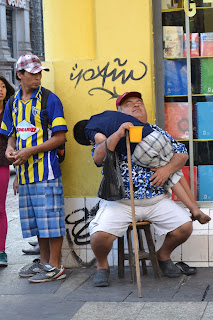A largish man in a velour tracksuit and sneakers, he stood in front of the statue of the Virgin, his arms outstretched, palms and face raised to the heavens in an intensely personal moment of faith.
In the States it's quite possible he would have been dismissed as a zealot. At the very least this display, so trusting and open, would have made some uncomfortable to be around.
But here, in Peru, it was utterly right.
It was a morning for gladness, to be sure; a clear, sunshine-filled Easter morning. Mike had made it through the airport and to the apartment before midnight the night before; record time, despite carrying technical work gear that had to be declared to Customs. Apparently his paperwork was thoroughly in order.
Engineer.
I had assumed Mike would be jet lagged and exhausted that first morning and guiltlessly had arranged to go for a run along the amazing coastline path with John. But no, he was invigorated and ready to go. Unfortunately he's too smart to run, so with a pang of guilt I left him back at the apartment, sipping coffee and hollering hellos and half conversations to coworkers on nearby balconies.
I went anyway. He's a big boy, right?
Complete and utter happiness: running with an old and true friend in a beautiful, foreign land.
Oh man, have I got it bad.
It is rather pretty, is it not?
We followed the Malecon cisneros, the road along the top of the cliff, up the coast and talked about nothing and everything, as we always have. Sometimes we ran on the running path, sometimes in the bike lane or over the neatly trimmed grass. But we got the heck out of the way when, from the other direction, large packs of fleet, determined-looking runners came swiftly toward us in the throes of marathon training.
They have it "more bad" than I do. Ha! A sense of normalcy is reintroduced. We were going for 5 or 6 kilometers, nothing major.
It felt amazing.
I had been filled with seemingly sourceless happiness more times in 3 days in Peru than I could remember in the entire last year. It was as though worries and cares were swept away by Pacific breezes.
We went, past exercise classes being held on the lawns, boom boxes whomping away, dogs looking adoringly up at their masters or being exhorted to chase a frisbee, little kids blowing bubbles or eating ice cream at 8 in the morning, soccer games, yoga devotees...
It felt alive to be there. Like waking from a long, tiring sleep and seeing the sunlight streaming in a window.
Almost too soon we turned back around. I could have gone forever, it seemed, though the niggling thought that Mike was waiting for us back at the apartment saved me from such whimsical, silly ideas.
And probably a pulled hamstring.
Nearing the end we were beginning to pant, and there, in the deep green grass, were some nice, athletic-looking folks in designer workout clothes handing out cups of Gatorade to passers-by.
John didn't hesitate, took one and then looked sideways at me.
I hesitated. "I dunno, John," trying to do mental actuarial tables, "this could be one of those mistakes."
The drink was out of a cooler, not bottles. Therefore reconstituted. Tap water.
Asking for it.
Everyone I know who has gotten sick in Peru, the Montezuma's Revenge sort of sick, has said the same wretched and very telling thing: I thought I was going to die.
We carry antibiotics now, when we travel to South America. Our doctor cheerfully prescribes them with a chipper, "hope you don't need them...but if you do...!"
When Mike had gotten terribly, worryingly sick in Peru, a few trips (for him) ago, he'd staggered out to buy Gatorade in the bottle, grabbed a purple pink one labelled "Gatorade Grenada", and had ended up with pomegranate flavor, which even in his desperate state had refused to drink.
There were about 300 reasons not to drink that stuff.
But I was thirsty. And I have an overdeveloped sense of macho...for a gringa.
Aw hell, I thought and grabbed a cup. "Bottoms up!" I clicked paper cups with John and threw back the orangy liquid, hoping for the best.
It was obviously a morning of miracles that day; neither of us got the least bit ill.
It probably didn't hurt that I managed to catch the end of an Easter service after I showered and changed and we slurped down our coffees so I could slip into the sanctuary of the beautiful Iglesia de la Virgen Milagrosa, full of songs or praise.
stained glass in the Iglesia de la Virgen Milagrosa (Church of the Virgin of Miracles)
There, worshipers wearing everything from their Easter best to yellow spandex worshipped side by side. Outside the street had been roped off for a sexy Sunday class of Zumba led by two enthusiastic fellows on an elevated stage.
Anything went, it seemed. All were welcome, body and soul, to worship as they wished.
fashioned from palm fronds
Not at all what I had envisioned for an Easter Sunday in a devout country. I as expecting seriousness. But this was joy. It was OK to run, or play with your dog, or go to church, or soak up the sun...whatever you liked. And I liked it.
I liked it a lot.



























.JPG)

